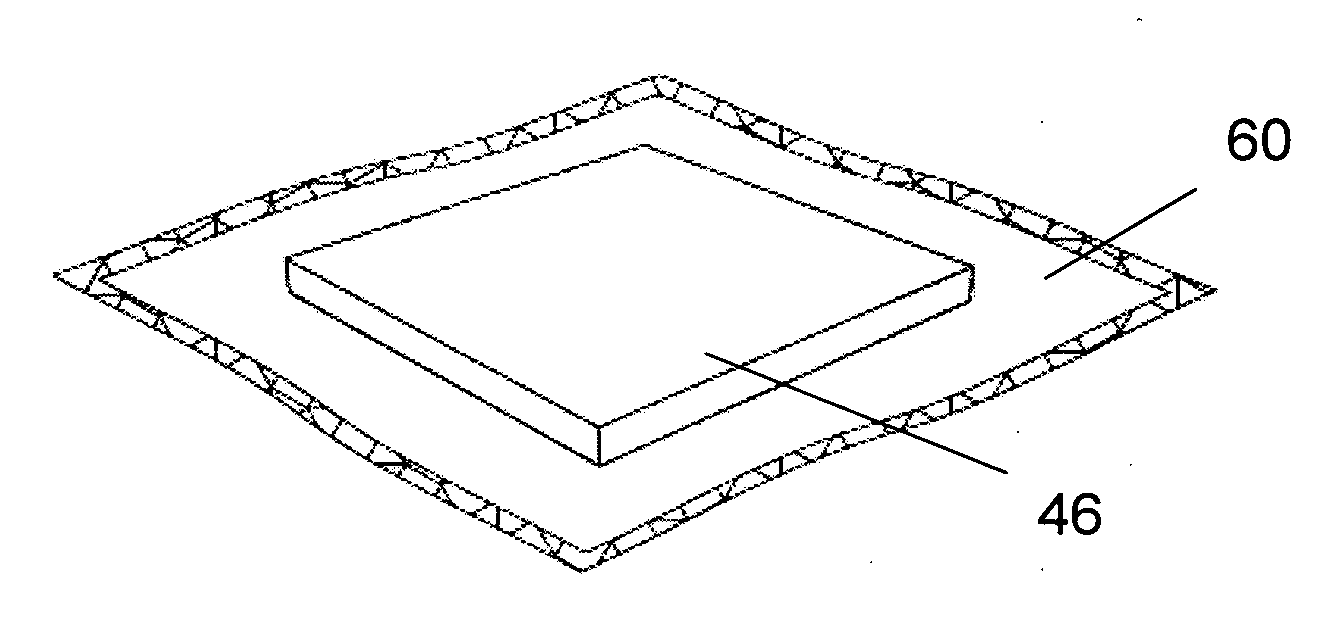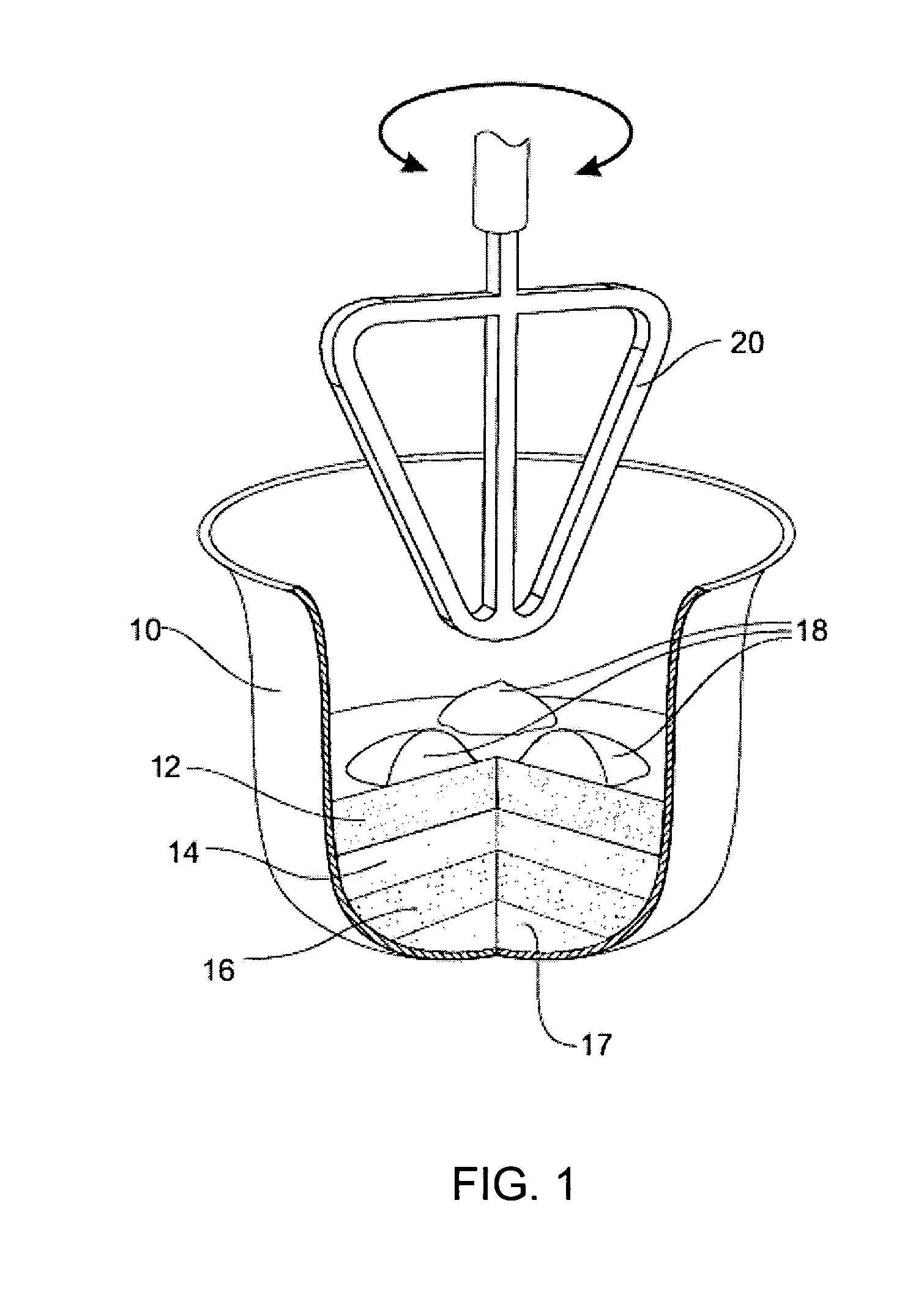This requires an interruption to the manufacturing process and the provision of sufficient storage space to store the slabs for curing in addition to the manually intensive processes associated with the removal of the slabs from their moulds and placing into storage for curing.
However, present production methods of tiles have a number of significant problems.
When
cutting a slab, which is a very hard material, the edges of the
cut are subject to varying degrees of chipping and rough edges.
Further, the slabs and / or tiles are liable to crack or break during the
cutting and calibrating process.
The stresses can cause chips and breakages, particularly at corners where the cementitious slab or the tiles are weakest.
The chipping,
cracking and / or breakages can result in wastage or the need to repair damaged material.
Another
disadvantage is that the
processing is difficult and requires care by skilled operators in order to ameliorate wastage due to chips, cracks and / or breakages.
Such skilled operators are costly and the production of the tiles from the slab is
time consuming and interrupts the production process.
The further storage of slab products for final curing represents additional handling and storage costs.
Other disadvantages in present production techniques include the need for expensive equipment for
cutting (including
diamond tools and large
capital equipment), large energy costs (for example,
electricity) and a large amount of water, which is consumed during the
processing of slabs into products.
The cutting and calibration processes also result in a large quantity of
waste material, which is created when material is removed during the cutting and calibration processes.
The separated
waste material must be collected, treated and disposed of, which may be inconvenient and / or expensive.
Further, the operational cost with respect to
electrical energy consumption of all the equipment is generally significant as most of the equipment needs a multi-purpose power supply.
The cutting process can be particularly wasteful when cutting small tiles or mosaic pieces as the
diamond cutting blade removes approximately 3 mm to 5 mm of material from each
cut.
Typically, preparing a factory for production of slabs and tiles is an expensive undertaking requiring a great deal of planning, preparation, construction and installation time.
In addition to all of the abovementioned disadvantages, the construction of a factory with special purpose drainage systems in itself represents a significant cost and hence an impediment to the establishment of a manufacturing facility.
However,
natural stone material has many variables which are difficult to control.
The stone material may be too soft, too hard, too porous or may have too many veins to be useful for a particular purpose.
Furthermore, such materials may not be aesthetically appealing for a customer or suitable for a particular application.
An additional problem in current production methods is that the tiles (or the slab) are subject to
efflorescence.
Efflorescence has always been a problem with cementitious products.
While
efflorescence does not compromise concrete's integrity, its effect on the aesthetic quality of products constitutes a costly problem for the industry.
In most cases, the residue cannot be simply rinsed off with
plain water, its removal requiring the application of weak acid and / or abrasion.
Thus, the cleaning process can be quite laborious depending on the extent of the efflorescence.
Furthermore, if the source of the water penetration is not addressed, efflorescence may reappear.
Water /
cement ratio is another significant factor, as increasing the water /
cement ratio leads to a more porous concrete matrix, which increases the potential for efflorescence by adding excessive water and creating easier pathways.
However, in climates where freezing is a concern, such a sealer may lead to damage from freeze / thaw cycles.
This process, however, can be difficult to control due to such factors as varying product densities, absorption rates,
moisture contents, air circulation, and
humidity levels.
However, during the processing of the slabs, a large quantity of water is used and this water can bring the
calcium hydroxide to the surface where it can react with
carbon dioxide in the
atmosphere and effloresce.
However, even a small amount of efflorescent
staining may be sufficient to adversely alter the true colour and / or intended finish of the material.
However, no manufacturer has completely eliminated the problem.
However, some acids may also react adversely with pigments used to colour concretes and can result in alarming colour changes.
Further, application of these cleaners can be quite laborious and time-consuming.
 Login to View More
Login to View More 


